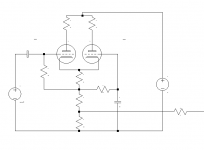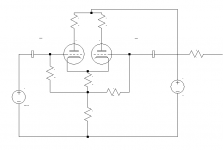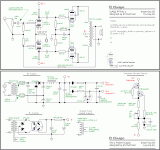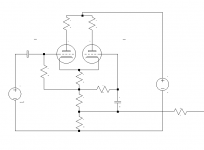Hi everyone.
I've come across many PA schematics using a LTP (aka Schmitt/Schimdt) stage, usually as input stage, which return the feedback from the OPT to the cathode, just like and ordinary common cathode stage.
Why not return the feedback to the grid of the usually grounded tube? Just like it is usual in solid state LTP input stages.
Just in case, both alternatives attached.
Any drawback that I might not be aware of?
I've come across many PA schematics using a LTP (aka Schmitt/Schimdt) stage, usually as input stage, which return the feedback from the OPT to the cathode, just like and ordinary common cathode stage.
Why not return the feedback to the grid of the usually grounded tube? Just like it is usual in solid state LTP input stages.
Just in case, both alternatives attached.
Any drawback that I might not be aware of?
Attachments
I use the grid as a gNFB return since the cathodes have no degeneration what so ever.
Since I only use one gain stage in my OTL ( a differential cascode stage) I get a higher output impedance if I use the same amount of gNFB in the cathode tham in the grid.
My output stage is a circlotron and it's referenced to ground... Exactly like the grids of the input LTP.
Since I only use one gain stage in my OTL ( a differential cascode stage) I get a higher output impedance if I use the same amount of gNFB in the cathode tham in the grid.
My output stage is a circlotron and it's referenced to ground... Exactly like the grids of the input LTP.
A few things to note....
When injecting on the tail....the FB also provides a " Bootstraping" affect... ie the effective AC tail impedance will increase significantly to better couple the phase inverter...
The second tube half V2 is acting as a Grounded-Grid amplifier... Having the Grid at AC ground makes for effective signal gain... While injecting a FB signal voltage on the grid of V2 you will need a impedance...
You may want to look further into analysis to see affect on CM rejection and AC gain balance...
When injecting on the tail....the FB also provides a " Bootstraping" affect... ie the effective AC tail impedance will increase significantly to better couple the phase inverter...
The second tube half V2 is acting as a Grounded-Grid amplifier... Having the Grid at AC ground makes for effective signal gain... While injecting a FB signal voltage on the grid of V2 you will need a impedance...
You may want to look further into analysis to see affect on CM rejection and AC gain balance...
Last edited:
Applying the NFB to the non-inverting grid works well, provided certain actions are taken. The tail load has to be a constant current sink (CCS), which forces symmetry between the 2 sides of the LTP. Also, the main NFB resistor should be non-inductive, as it's working into the high grid impedance. SY made that point, years ago, during the development of "El Cheapo". Meter match carbon composition parts, for service in the 2 stereo channels.
Attachments
What brand? If they make guitar amps too then the circuit may be inherited from the classic guitar amp LTP. This applies FB to the grid, but also a small amount to the tail. The only reason it was done this way is because it was easier for layout in the original Fender Bassman; there was no other design reason for it.I've come across many PA schematics using a LTP (aka Schmitt/Schimdt) stage, usually as input stage, which return the feedback from the OPT to the cathode, just like and ordinary common cathode stage.
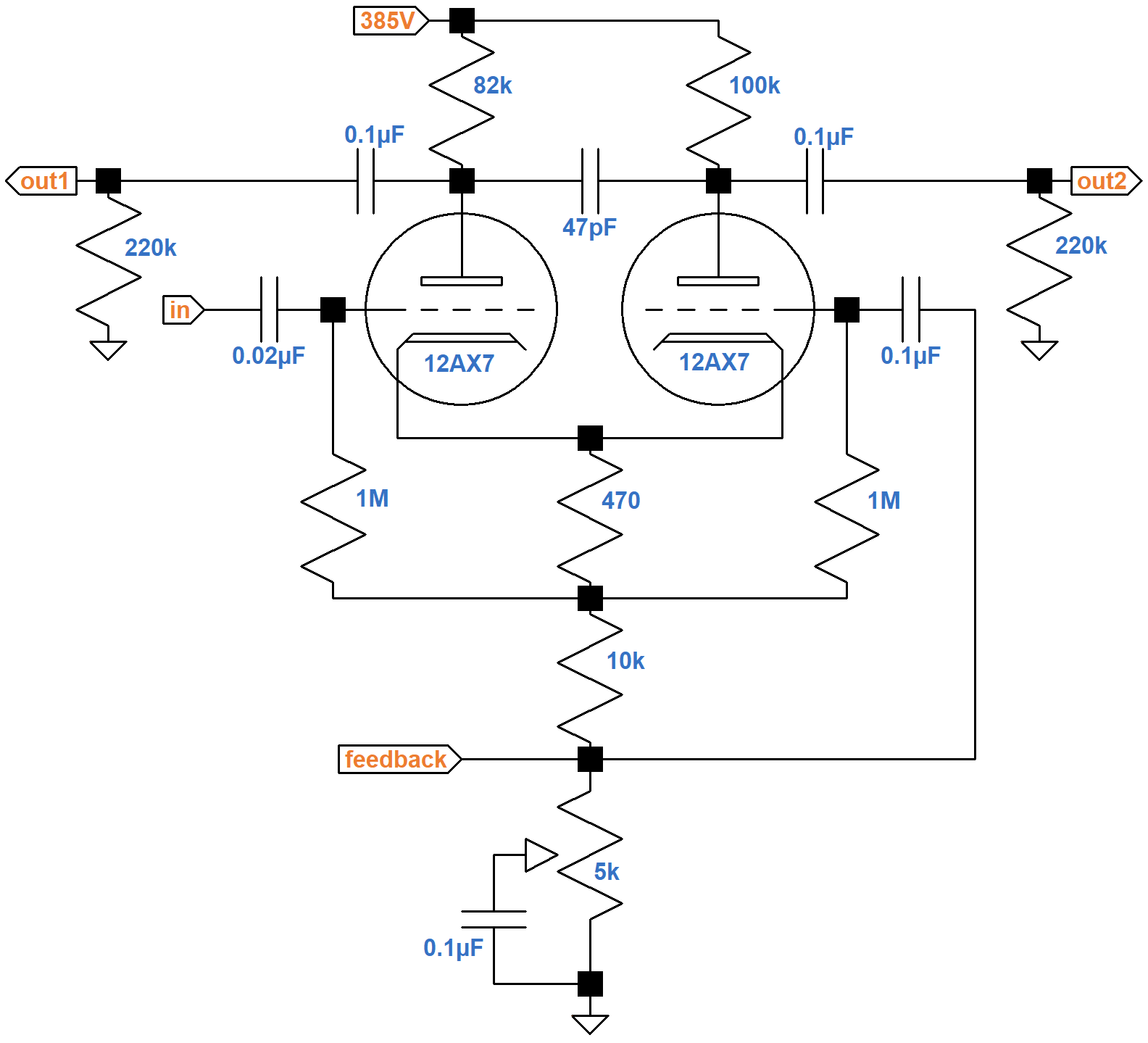
Wow this image is big.
Last edited:
What brand?
I didn't pay attention to the brand. Some of them are from DIYs.
There're examples in "Principles of Power" from Kevin O'Connor. Most of them are guitar amp's input stages. There's at least one hi-fi input stage for a high power PA too. None of them use CCS, but resistive tail. All of them use the same feedback circuit you posted, to both cathode and grid.
Wow this image is big.
Last edited:
...many PA schematics using a LTP ... stage, usually as input stage, which return the feedback from the OPT to the cathode...
Name some.
Your 1st drawing will NOT work as expected. It wants the offside grid cap returned to the tail tap, not to ground.
The form with NFB to tail-tap appears to be a Fender "mistake" which gave "interesting" sound. It was copied near verbatim into Marshall and after that, everybody.
The form with NFB to offside grid is "correct" and will work just fine.
Your 1st drawing will NOT work as expected. It wants the offside grid cap returned to the tail tap, not to ground.
The form with NFB to tail-tap appears to be a Fender "mistake" which gave "interesting" sound. It was copied near verbatim into Marshall and after that, everybody.
Yes, updated my drawing.
Why a "mistake"?
Attachments
- Status
- This old topic is closed. If you want to reopen this topic, contact a moderator using the "Report Post" button.
- Home
- Amplifiers
- Tubes / Valves
- LTP feedback return. Cathode or grid?
